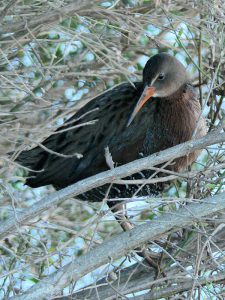Light-footed Ridgeway’s Rail (formerly known as Clapper Rail), are federally listed as endangered. They can be difficult to see here in Orange County California. Unless you know when and where to look, you will rarely get a close-up. They occasionally appear at Bolsa Chica Ecological Reserve in Huntington Beach. But until recently, they have been few and far between. They still are not seen at Bolsa Chica with the regularity, quantity, or visibility of Upper Newport Bay during winter high tides.
Even though this Ridgeway’s Rail had been reported, I was surprised to drive into the parking lot at Bolsa Chica and hear it calling loudly, looking for love almost continuously in early July. I could barely see him through the vegetation lining the parking lot, so I walked around to the far side of the mule fat to see if I could get a decent look. There he was, looking for love, at almost point blank range (about 20 yards from me and about the same distance from Pacific Coast Highway). What an opportunity to take some video to try out the new Kowa TE-11WZ 25-60x wide angle eyepiece on my Kowa TSN-884 spotting scope! You can see the rail’s body shake with every call, and if you look closely, you can see his tongue.

My visit was in the middle of his three-week stay. He did not seem to be successful in finding a mate during that time. Hopefully, he moved on to greener pastures (or marshes, as the case may be).
It’s Been Getting Better
p.s. In July, 2014, a family with two chicks was seen in the same spot. Maybe he got lucky after all.
p.p.s. When I wrote this article in July 2013, Ridgeway’s Rail was known as Clapper Rail. In July 2014, the American Ornithological Union split Clapper Rail into three separate species. The eastern races of Clapper Rail from the Gulf Coast and southern Atlantic coast are still Clapper Rail. Ridgeway’s Rail applies to races from the southwest in western New Mexico through coastal California. The third split, Montezuma’s Rail, live in Central Mexico.

